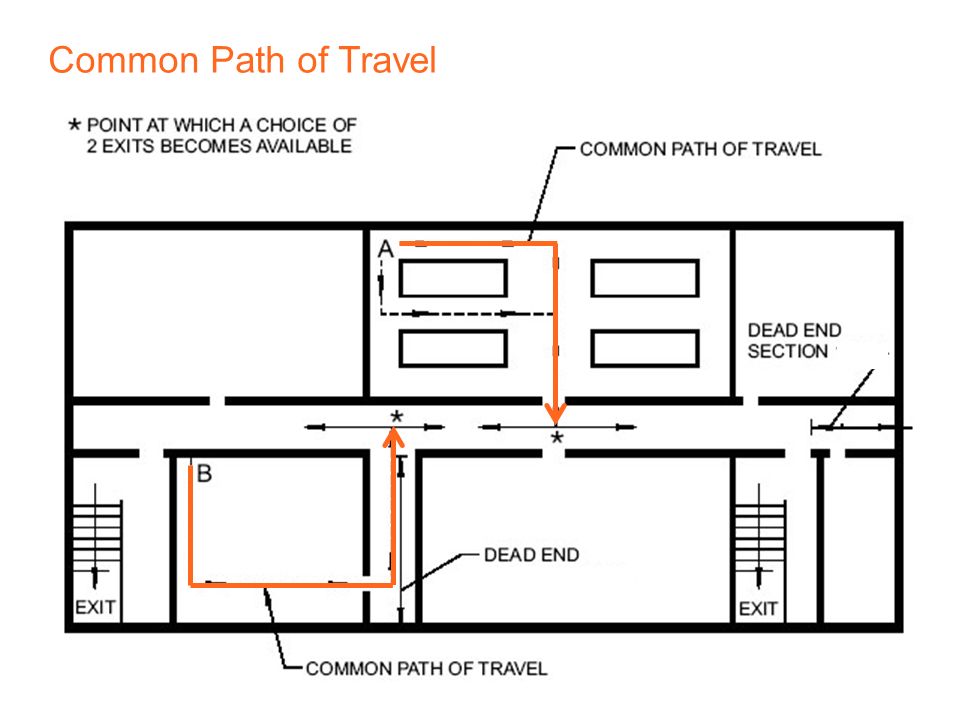 Common Path of Travel[/caption]
Common Path of Travel[/caption]
| OCCUPANCY TYPE (new building) |
CODE REF. | COMMON PATH OF TRAVEL |
| AMBULATORY (Not Sprinklered) |
(20.2.5)(38.2.5.3) | 23 m 30 m if within single tenant space and occupant load <30 people |
| AMBULATORY (Sprinklered) |
(20.2.5)(38.2.5.3) | 30 m |
| ASSEMBLY (Sprinklered and not sprinklered) |
(12.2.5) | 6.1 m if OL >50, 23 m if OL <50 |
| BUSINESS (Not Sprinklered) |
(38.2.5.3) | 23 m 30 m if within single tenant space and occupant load <30 people |
| BUSINESS (Sprinklered) |
(38.2.5.3) | 30 m |
| HEALTHCARE (Sprinklered and not sprinklered) |
(18.2.5.3) | 30 m |
| EDUCATIONAL (Not Sprinklered) |
(14.2.5.3) | 23 m |
| EDUCATIONAL (Sprinklered) |
(14.2.5.3) | 30 m |
| ONE & TWO FAMILY DWELLINGS |
(-) | No Requirements |
| HOTELS AND DORMITORIES (Not Sprinklered) |
(28.2.5.3) | 10.7 m (travel within guest room shall not be included) |
| HOTELS AND DORMITORIES (Sprinklered) |
(28.2.5.4) | 15 m (travel within guest room shall not be included) |
| APARTMENTS (Not Sprinklered) |
(30.2.5.3) | 10.7 m (travel within dwelling unit shall not be included) |
| APARTMENTS (Sprinklered) |
(30.2.5.3) | 15 m (travel within dwelling unit shall not be included) |
| MERCANTILE (Not Sprinklered – Low or Ordinary hazard) |
(36.2.5.3) | 23 m, (no common path of travel allowed in high hazard areas) |
| MERCANTILE (Sprinklered – Low or Ordinary Hazard) |
(36.2.5.3) | 30 m |
| STORAGE (Not Sprinklered) |
(Table 42.2.5) | 15 m, (no common path of travel allowed in high hazard areas) |
| STORAGE (Sprinklered) |
(Table 42.2.5) | 30 m |
| INDUSTRIAL |
(Table 40.2.5) | Refer to Table 40.2.5 |
Common Path of Travel is defined as “that portion of the exit access which the occupants are required to traverse before two separate and distinct paths of egress travel to two exits are available”. Because the code requires a minimum of two exit paths from a building, as a person exits a space they will come to a point where they can go one direction to get to one exit or another direction to get to a different exit. The distance traveled from any point within a space to this diverging point is the Common Path of Travel.
Notes:
- Code Reference used is NFPA-101 2012 edition unless otherwise noted.
- These information is not complete and intended to be used as quick references only, always refer to NFPA or your local codes for complete information.